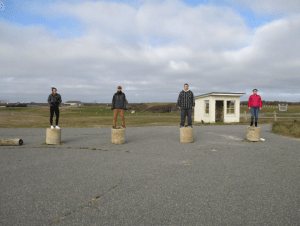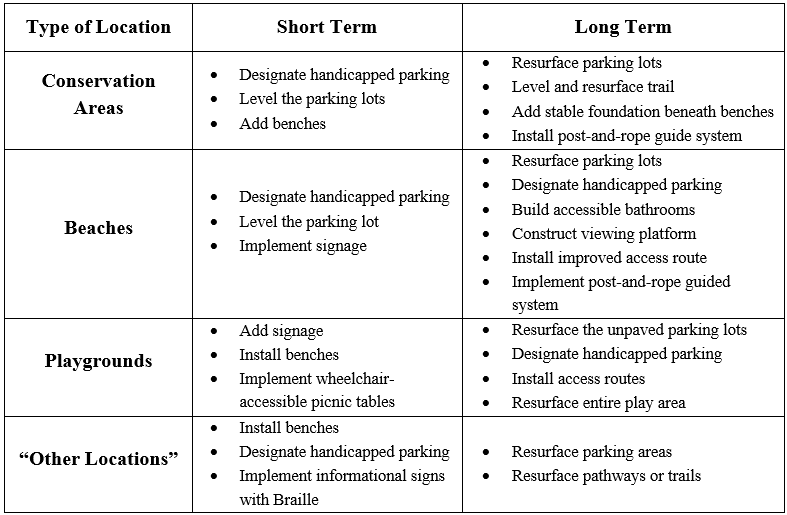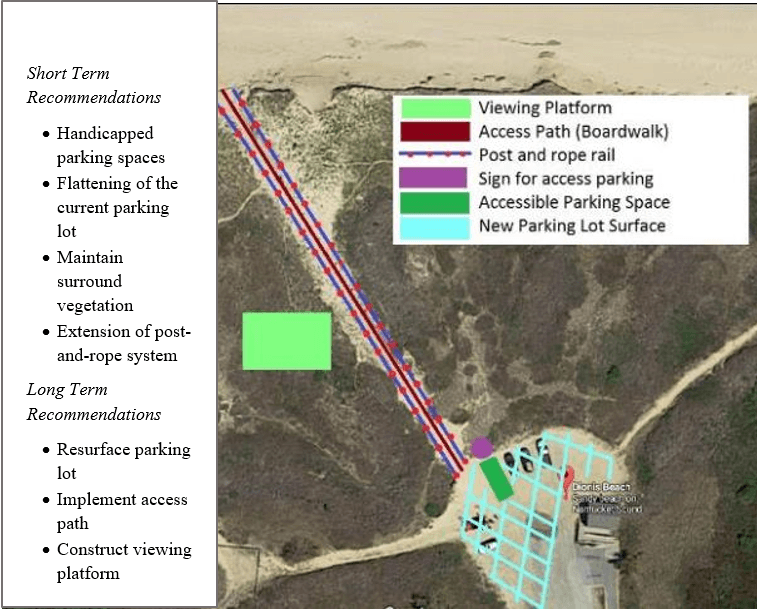Promoting Access for Those with Disabilities to the Outdoors on Nantucket: Assessment and Communication
| Sponsor: | Nantucket Commission on Disability |  |
| Sponsor Liaison: | Brenda McDonough and Mickey Rowland | |
| Student Team: | Gillian Colman, Danielle Cote, Nathan Hague, and Jared Perkins | |
| Abstract: | The goal of the Nantucket Commission on Disability (NCOD) is to fully integrate those with disabilities into the Nantucket community. This includes helping everyone experience the outdoor areas on the island. To aid in this mission, our team worked with NCOD to determine and communicate the accessibility at a variety of outdoor locations. We developed a methodology for assessing conservation area trails, public beaches, and public playgrounds based on published standards. Our final products included this report, a database of data from all assessed locations, a reference guide with detailed findings and recommendations to improve the accessibility at all the visited properties, and multiple webpages, one with an interactive map, that communicate current accessible locations on the island. | |
| Link: |
Final Report: ncod_iqp-final-report Final Presentation: ncod-final-presentation Executive Summary: ncod_executive-summary Reference Guide of Assessed Locations: ncod_reference-guide-of-assessed-locations |
|
Executive Summary
Introduction
The disabled population consists of people who have restrictions with movement, activities, and/or senses due to mental or physical conditions (Office of Disability Employment Policy). Since 1968 the United States has made efforts to include those with disabilities in the national community with the formation of laws and organizations, such as the Architectural Barriers Act (ABA) of 1968, the Access Board in 1973, and the Americans with Disabilities Act (ADA) of 1990 (United States Access Board, 2013).
Although the ADA and ABA acts are designed to improve accessibility, the ABA standards for developed outdoor areas were not published until 2013. As a result, there are still many recreational areas such as trails, beaches, playgrounds, and outdoor locations that are not accessible to those with disabilities and could potentially be improved to increase disability access, including on Nantucket.
Much can be learned from other communities as to how they have approached the problem of implementing accessible features into recreational areas. For example, the Falls Village case study of the Appalachian Trail Re-Design of 2007 addressed issues of uneven terrain and erosion in their renovation of the trail (Demrow, 42). Also, a great example for accessible playgrounds is the Can-Do Playground, in Delaware, which is fully ADA compliant and consists of equipment encouraging tactile and physical play (Richards, n.d.).
While other places have made progress with accessible outdoor recreational locations, it is important to note there has also been progress on Nantucket to increase the accessibility of the island. The mission of the Nantucket Commission on Disability (NCOD) is “for the disabled population to fully integrate and participate in the Nantucket community” (Town of Nantucket, Commission on Disability, n.d.). Since 1990 NCOD has been conducting research on access problems of island residents with disabilities and recommending policies and changes to ensure those with disabilities are represented and accommodated. Through such activities they have had town sidewalks repaired, and provided parking permits to those who are disabled.
The Nantucket Commission on Disability has also partnered with other town organizations to improve the accessibility of recreational outdoor areas, including conservation land, playgrounds, and beaches. For example, since the spring of 2016, NCOD has worked with the Nantucket Islands Land Bank Commission to improve some of their trails and beaches (McDonough, Sept. 26, 2016).
Although NCOD has made progress in outdoor recreational areas, the island still has potential for more outdoor accessibility projects to be completed. Nantucket’s outdoor recreational areas provide vistas with much to be seen and enjoyed. If the outdoor recreational areas were altered, those with disabilities could be given better access.
Objectives and Methodology
The mission of this project was to advance the outdoor leisurely opportunities for the those with disabilities and improve the quality of their recreational experience on Nantucket.
Addressing the goals and objectives of this project, outlined below, began during our preparation term on campus in Worcester and then completed on island.
- Assess the current accessibility at a majority of the trails, beaches, and playgrounds on Nantucket by creating a methodology for assessing
each type of location and a database where this information could be easily stored, analyzed, and accessed. - Provide recommendations for accessibility improvements at each assessed area, based on our site analyses, detailed designs, models,
background research, and stakeholder input. - Communicate the current accessibility features, as well as possible improvements, at each assessed location to people with disabilities
through the creation of a webpage where this information can be publicly accessed.
The flowchart below illustrates our work to achieve our objectives.
Project Overview
Interviews and Surveys
When we arrived on the island our first task was to identify key stakeholders so that we could interview and survey them about the most popular areas to visit, which outdoor locations needed the most improvements and if conservation owners were willing to aid in the renovations. These key stakeholders included, among others, conservation groups and members of both the disabled and non-disabled communities.
Outdoor Area Assessment
Next we visited trails in conservation areas, public beaches, and public playgrounds, and assessed current accessibility using guidelines set forth by the ABA and ADA, a checklist provided by the company GameTime, the Universal Trail Assessment Process (UTAP), and a scholarly report on the accessibility of trails and parks in British Columbia. Our method for assessing the accessibility of each site followed a general series of steps;
- Create a checklist of features and amenities to measure and observe at each location based on published standards and other background research
- Identify appropriate sites to visit for each of the main outdoor area types: trails, beaches, playgrounds
- Visit sites and make appropriate measurements, take pictures, etc.
- Transfer data into a database
- Summarize the data from the database into another template including the qualitative data, and short and long term recommendations
- Compare results from each visited location to published standards and recommendations
- Draw conclusions for accessibility by different type of disability, make recommendations, prioritize, etc.
Findings and Results
Interviews and Survey
Through the interviews of conservation groups, we found the majority of the conservation groups have open minds to making improvements to their properties to better accommodate those with disabilities. The Massachusetts Audubon Society is a great exemplar of a group whose properties accommodate those with disabilities. The Massachusetts Audubon Society 12 accessible properties throughout the whole state, and hopes to improve the two they own on Nantucket.
Our qualitative community survey also helped us gauge viewpoints of accessibility on the island. We heard from 28 residents who both reinforced the perceptions we had of the island’s accessibility as well as gave us additional insights. For example, the responses informed us that many of the beaches are inaccessible due to the absence of access mats/surfaces for steep and sandy terrain, or designated handicapped accessible parking spaces.
Below is a summary of our general findings at the different types of locations;
Conservation Areas
- All of the parking lots of the assessed locations were dirt, grass, sand, or gravel which limits the ability of those with disabilities tp traverse the parking lots.
- Many locations did not have designated accessible parking which would provide the shortest possible access route to the entrance.
- The trails are uneven which increases the chance of tripping and falling.
- More than half of the locations did not have benches which limits those who cannot walk or stand for a long time because they do not have places to rest.
- The bathrooms were non-existent, and/or not handicapped accessible which limits the time someone can spend at the conservation area because if they have to use the facility they must leave.
- The entrances have obstructions that limit or prevent wheelchair and other mobility assistive device access.
Beaches
- The parking lot surfaces varied between all beaches with some more uneven and harder to traverse than others depending on the surface.
- Three of the eleven beaches assessed had paved parking lots and accessible parking spaces to increase the stability of the surface those with disabilities traverse over.
- Less than half of the beaches had accessible bathroom buildings to allow people to stay at the beaches longer.
- The entrances have good width to allow those with mobility assisting equipment to go through but their steep slopes increase the chance of losing balance.
- More than half of the beaches have signage that indicates their emergency location number so if anyone gets injured, people can easily notify responders where they are.
- None of the beaches had permanent access routes from the beach entrances.
- The nature of the sand and surf depended on the region the beach is located in.
Playgrounds
- The surface of playground parking lots varied depending on the distance of the playground from town.
- The amount of parking spaces and accessible parking spaces at each playground varied.
- Measured parameters for playground entrances met standards so those in wheelchairs can easily enter and exit the playground.
- Every playground surface is sand which is an unstable surface
- The play component measurements are compliant with standards so children can easily and safely utilize the playground.
- The physically engaging play components were too rigorous to accommodate multiple disabilities, therefore, it was inaccessible.
- There are multiple benches present at all of the playgrounds to allow those who cannot stand for extensive periods of time to rest.
- There was sensory play at 4 of the 5 playgrounds to engage children and their imaginations in other ways besides their motor skills.
“Other Locations”
- All of the parking lots were either dirt or grass, making them uneven and creating instability.
- None of the locations had accessible parking spaces to prevent those with mobility assisting equipment to be limited for space.
- The uneven pathways of 3 of the 9 properties cause instability for those traversing over them and increase the probability of someone tripping and/or falling.
- The cliffs and water adjacent to 6 out of the 9 properties without any barrier make those with disabilities more susceptible to falling over the drop-offs or into the water.
Recommendations
Using the results from the assessment process, our background research and case studies we proposed and documented both short term and long term accessibility recommendations for each location based on feasibility. The analysis of feasibility included: popularity of the location, items needing improvements, extensiveness of needed accessibility improvements, and willingness of the property owner to improve accessibility. The following are general recommendations for each type of locations;
General Recommendations for Location Types
In-depth designs were developed for select locations as examples of what is possible to enhance accessibility for those with disabilities. These properties were selected considering the ease of being granted permission by the owners, and the intensity of the labor required to implement the recommendations. These designs were visualized using the photography of the specific locations and, once developed, illustrated through diagrams.
Below are the short and long term recommendations developed for Dionis Beach, one of the five locations we did in-depth analyses for. Included in the diagram for Dionis Beach (below) are illustrations of our recommendations.
Dionis Beach Recommendations
Final Products
Assessed Locations Database
The completed spreadsheets for each assessed location were combined into a single database where all of the quantitative and qualitative assessment data can be found for each assessed outdoor location. In this database, each spreadsheet was developed from one of the three basic types of “templates” we developed with parameters to assess and measure corresponding to the type of location evaluated.
Reference Guide of Assessed Locations
We also combined the templates for site presentation we developed into a single reference guide as a summary of our findings and recommendations. The figure below demonstrates an example of one of the completed templates we developed to summarize our findings and recommendations for a specific location. NCOD can distribute this guide to the appropriate parties so that they may review it and decide if they would like to improve the location. As the location is improved notations can be made of the additional features and who the location is now accessible to.
Example of one of the templates in Reference Guide (Crabbing Spot 1)
Webpages
The next product we developed for the Nantucket Commission on Disability was webpages providing information on accessible locations within the downtown area, resources for those with disabilities, and information detailing all of the currently accessible locations we assessed through an interactive map. A brief description of each location and its current accessible features were included on a separate page. The Commission can update the site descriptions as new accessible features are installed, as well as any other content that may need to be updated. The webpage can be found on the Nantucket government website through the services tab or by searching key words such as “accessibility” or “disability”.
Interactive Map from New Webpage
Lastly, we produced a final report detailing all of our background research, case studies, methodology, results, and conclusions made from our project.
Conclusion
By developing better means of communicating the accessibility of outdoor locations on Nantucket, we believe residents and visitors with disabilities will be more apt to know which areas would be easiest to visit and to make plans accordingly. The Nantucket Commission on Disability hopes to continually update the website to provide the public with accurate information on outdoors accessibility. Additionally, with the recommendations formed, the locations assessed can be improved by advancing the access for those with disabilities when they do visit. Through the proposed recommendations, NCOD looks forward to having more organizations contribute to the NCOD mission in ensuring those who are disabled feel a part of the whole community when visiting the outdoor recreational areas on Nantucket.
References
Demrow, Carl C. (2007, March). Increasing Opportunities for Access on the Appalachian Trail: A Design Guide. Retrieved September 5, 2016, from http://www.appalachiantrail.org/docs/appalachian-trail-club-leaders/2011/04/14/increasing-opportunities-for-access-on-the-appalachian-trail_a-design-guide.pdf.
McDonough, B. (2016, September 26). Personal phone interview. Conducted by Colman, G., Cote, D., Hague, N., Perkins, J..
Office of Disability Employment Policy. (n.d.). Frequently Asked Questions. Retrieved October 12, 2016, from https://www.dol.gov/odep/faqs/general.htm.
Richards, P. (2014, July 9). ZBA to Hear Sconset Playground Appeal Thursday. Retrieved September 11, 2016, from http://www.ack.net/ZBAplaygroundappeal070914.html.
Town of Nantucket. (n.d.). Commission on Disability. Retrieved September 05, 2016, from http://www.nantucket-ma.gov/302/Commission-on-Disability.
United States Access Board. (2013, September 26). The Rehabilitation Act and Creation of the Access Board. Retrieved November 14, 2016, from https://www.access-board.gov/news/1512-the-rehabilitation-act-and-creation-of-the-access-board.







